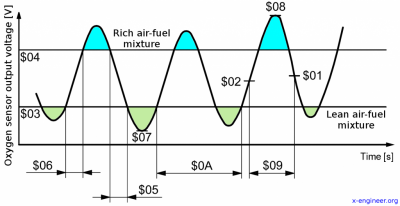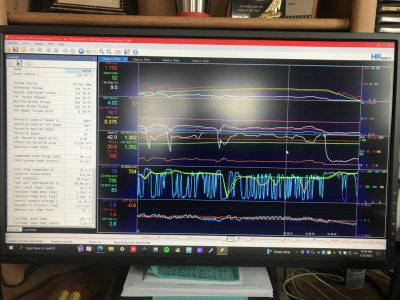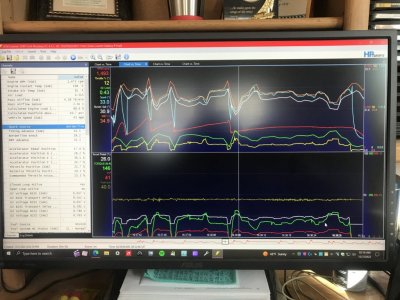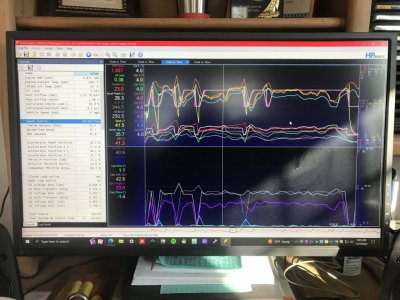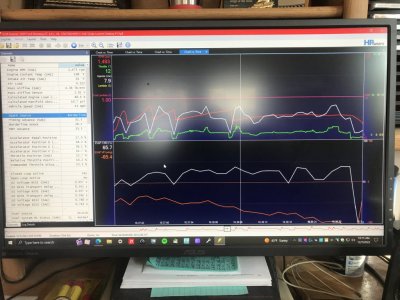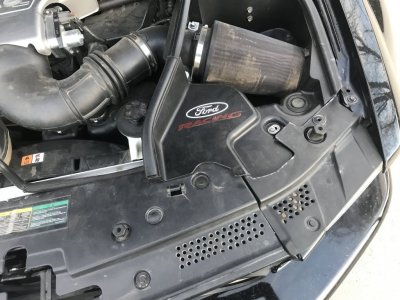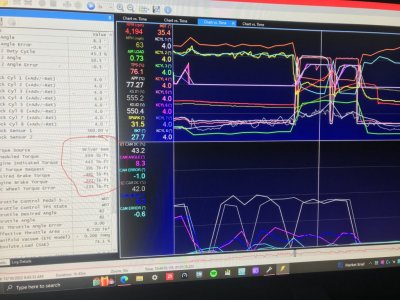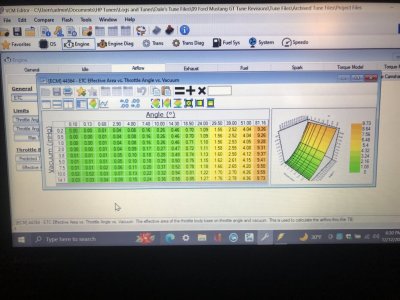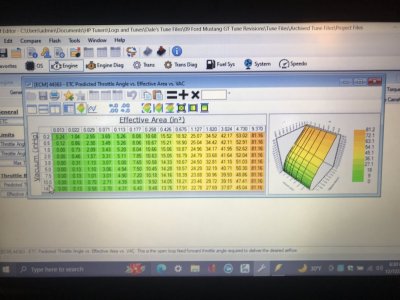GlassTop09
Senior Member
FYI........................
Here is provided some cat CE ratio results of my engine's PCM OBDII cat monitoring algorithm since me flashing in latest tune rev #32 which I revamped the VCT airload load% map & both Spark Advance\BKT & MBT VCT Spark Adder map settings to increase engine TQ output between .10 load thru .70 load areas to improve engine's part throttle drivability response while in CL Normal Mode:
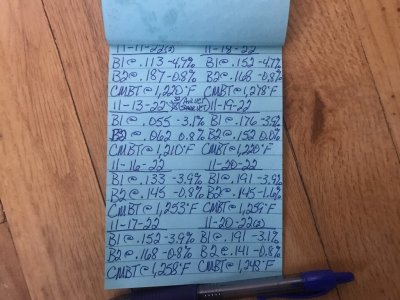
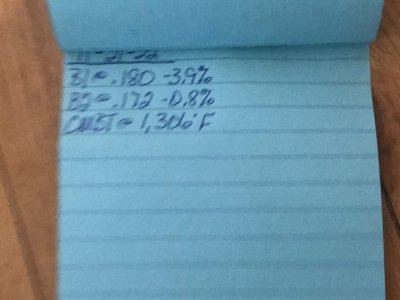
Please note how the PCM is handling the cat CE ratio results since the initial DC where the PCM recorded the initial CE ratio results over subsequent Mode 6 Cat CE Ratio checks of these MF #5461336 CARB-cert TWC aftermarket cats as read from my trusty Foxwell NT301 general OBDII scan tool (that I keep stored in the car.......I have a general OBDII scan tool stored in all of our vehicles for monitoring purposes if a MIL lights up to see what's going on & to see if the DTC noted prevents the vehicle from being driven until I can address it......driving used vehicles).
You can clearly see where the PCM caught up w\ B2 cat 1st to get it under control then follow up catching up w\ B1 cat from today's drive\check then brought up B2 to match as both engine banks cats are monitored\adjusted by PCM using the O2 sensor feedback from both the front & rear O2 sensors during engine operation which includes EVAP purging, any environmental airmass changes that affect the MAF readings (like following behind other vehicles for starters thus engine is ingesting other vehicle's exhaust fumes into CAI which will throw off the calibrated MAF sensor airload calc's vs the LWFM MAF airload calc'd tables that PCM uses to check the MAF sensor accuracy to maintain accurate fueling along w\ the NB O2 sensor's STFT+LTFT O2 feedback while operating in CL Normal Mode.....what MAF Adaption is designed to compensate for) AND catalyst monitoring\operational maintenance. Also note how closely the engine idle LTFT readings are maintained thruout thus is indicative of how steady the PCM is also controlling the engine's AFR thru the EQ Ratio Lambda 1.0 formula using the fuel stoich AFR setting of 14.13 which matches the E10 unleaded 91 oct fuel's stoich AFR being burned by engine.
The PCM will continue to monitor\adjust this until the CE ratio results settle out & remain within a set range based on all the current tuning changes, engine usage concerning load%, environmental airmass changes encountered as well as the MF #5461336 cats' ability to adequately treat the exhaust they get from this modded engine's exhaust output. The PCM Cat CE Ratio max thresholds in tune are set @ .660 for both B1\B2 (the highest LEGAL threshold settings the PCM's current OS firmware will allow for this '09 MY S197) thus as you can also see, ain't nowhere close to the thresholds.......this is from an FBO, SBE NA 4.6L V8 equipped w\ a non-stock CAI (well, the Bullitt CAI is an OEM FoMoCo CAI but it didn't come installed from factory w\ this MY GT so is not "OEM"), non-stock TB (FP 62mm TB now correctly setup in tune), '08 OEM IM w\ CMCV's removed (the remedy to fix the EVAP issue caused by the FP 463V IM's bad EVAP port routing design into its plenum that helped cause the erroneous cat CE P0420\P0430 DTC's & also dyno tested\proved to not cause practically any HP\TQ loss w\ deleted CMCV's), Kooks 1 5\8" LTH's using corrected O2 transport delay timing settings that match the header's O2 sensor location & X-Pipe fitted w\ MF #5461336 CARB-cert TWC aftermarket cats that match this vehicle's VEI EFN# thus EPA legal & fitted w\ NGK 22060, 22500 NB O2 sensors running a set of Lunati VooDoo #21270700 aftermarket NSR\full VCT-compliant non-stock camshafts that are tuned using a highly modified tune file from OEM that has all pertinent OEM tune settings enabled\set to maintain good emissions compliance while also pushing as high a HP\TQ output as can be achieved.....safely & reliably.
So yes, this can be easily done w\ a NA 4.6L V8 using all aftermarket parts as long as the tuning that the PCM needs to properly maintain\control the cats CE ratio output thus emissions compliance is left intact & operational in tune file as none of it has any effect on the engine's ability to make max HP\TQ while NA......and the aftermarket parts being used don't cause an adverse effect to the PCM's ability to control\maintain the cats emissions compliance.
The only aftermarket part I found to yet have an adverse effect was the FRPP IM thru its poor EVAP port routing design. If Ford had designed this port like they did for the OEM IM, this aftermarket FRPP IM would have been fully capable of EPA certification.......only downside is that you couldn't have used an aftermarket mono blade TB on it...............
PS edit--If no one is actually monitoring the PCM Cat CE ratio test results or using a 5-gas analyzer to check engine exhaust while tuning these engines, you'd be in a very bad position of potentially misunderstanding how Ford set all this up & how all this actually works & is interrelated\integrated in this factory SO PCM's operations, thus can easily mess this up by unnecessarily altering\disabling needed settings in tune file to manage emissions that do not affect engine max HP\TQ output at all.....causing this engine to fail emissions cert tests it really shouldn't be failing. Aftermarket components usage for the most part w\ very few exceptions, isn't the problem.....................
My 2 cents.................
Here is provided some cat CE ratio results of my engine's PCM OBDII cat monitoring algorithm since me flashing in latest tune rev #32 which I revamped the VCT airload load% map & both Spark Advance\BKT & MBT VCT Spark Adder map settings to increase engine TQ output between .10 load thru .70 load areas to improve engine's part throttle drivability response while in CL Normal Mode:


Please note how the PCM is handling the cat CE ratio results since the initial DC where the PCM recorded the initial CE ratio results over subsequent Mode 6 Cat CE Ratio checks of these MF #5461336 CARB-cert TWC aftermarket cats as read from my trusty Foxwell NT301 general OBDII scan tool (that I keep stored in the car.......I have a general OBDII scan tool stored in all of our vehicles for monitoring purposes if a MIL lights up to see what's going on & to see if the DTC noted prevents the vehicle from being driven until I can address it......driving used vehicles).
You can clearly see where the PCM caught up w\ B2 cat 1st to get it under control then follow up catching up w\ B1 cat from today's drive\check then brought up B2 to match as both engine banks cats are monitored\adjusted by PCM using the O2 sensor feedback from both the front & rear O2 sensors during engine operation which includes EVAP purging, any environmental airmass changes that affect the MAF readings (like following behind other vehicles for starters thus engine is ingesting other vehicle's exhaust fumes into CAI which will throw off the calibrated MAF sensor airload calc's vs the LWFM MAF airload calc'd tables that PCM uses to check the MAF sensor accuracy to maintain accurate fueling along w\ the NB O2 sensor's STFT+LTFT O2 feedback while operating in CL Normal Mode.....what MAF Adaption is designed to compensate for) AND catalyst monitoring\operational maintenance. Also note how closely the engine idle LTFT readings are maintained thruout thus is indicative of how steady the PCM is also controlling the engine's AFR thru the EQ Ratio Lambda 1.0 formula using the fuel stoich AFR setting of 14.13 which matches the E10 unleaded 91 oct fuel's stoich AFR being burned by engine.
The PCM will continue to monitor\adjust this until the CE ratio results settle out & remain within a set range based on all the current tuning changes, engine usage concerning load%, environmental airmass changes encountered as well as the MF #5461336 cats' ability to adequately treat the exhaust they get from this modded engine's exhaust output. The PCM Cat CE Ratio max thresholds in tune are set @ .660 for both B1\B2 (the highest LEGAL threshold settings the PCM's current OS firmware will allow for this '09 MY S197) thus as you can also see, ain't nowhere close to the thresholds.......this is from an FBO, SBE NA 4.6L V8 equipped w\ a non-stock CAI (well, the Bullitt CAI is an OEM FoMoCo CAI but it didn't come installed from factory w\ this MY GT so is not "OEM"), non-stock TB (FP 62mm TB now correctly setup in tune), '08 OEM IM w\ CMCV's removed (the remedy to fix the EVAP issue caused by the FP 463V IM's bad EVAP port routing design into its plenum that helped cause the erroneous cat CE P0420\P0430 DTC's & also dyno tested\proved to not cause practically any HP\TQ loss w\ deleted CMCV's), Kooks 1 5\8" LTH's using corrected O2 transport delay timing settings that match the header's O2 sensor location & X-Pipe fitted w\ MF #5461336 CARB-cert TWC aftermarket cats that match this vehicle's VEI EFN# thus EPA legal & fitted w\ NGK 22060, 22500 NB O2 sensors running a set of Lunati VooDoo #21270700 aftermarket NSR\full VCT-compliant non-stock camshafts that are tuned using a highly modified tune file from OEM that has all pertinent OEM tune settings enabled\set to maintain good emissions compliance while also pushing as high a HP\TQ output as can be achieved.....safely & reliably.
So yes, this can be easily done w\ a NA 4.6L V8 using all aftermarket parts as long as the tuning that the PCM needs to properly maintain\control the cats CE ratio output thus emissions compliance is left intact & operational in tune file as none of it has any effect on the engine's ability to make max HP\TQ while NA......and the aftermarket parts being used don't cause an adverse effect to the PCM's ability to control\maintain the cats emissions compliance.
The only aftermarket part I found to yet have an adverse effect was the FRPP IM thru its poor EVAP port routing design. If Ford had designed this port like they did for the OEM IM, this aftermarket FRPP IM would have been fully capable of EPA certification.......only downside is that you couldn't have used an aftermarket mono blade TB on it...............
PS edit--If no one is actually monitoring the PCM Cat CE ratio test results or using a 5-gas analyzer to check engine exhaust while tuning these engines, you'd be in a very bad position of potentially misunderstanding how Ford set all this up & how all this actually works & is interrelated\integrated in this factory SO PCM's operations, thus can easily mess this up by unnecessarily altering\disabling needed settings in tune file to manage emissions that do not affect engine max HP\TQ output at all.....causing this engine to fail emissions cert tests it really shouldn't be failing. Aftermarket components usage for the most part w\ very few exceptions, isn't the problem.....................
My 2 cents.................
Last edited:


